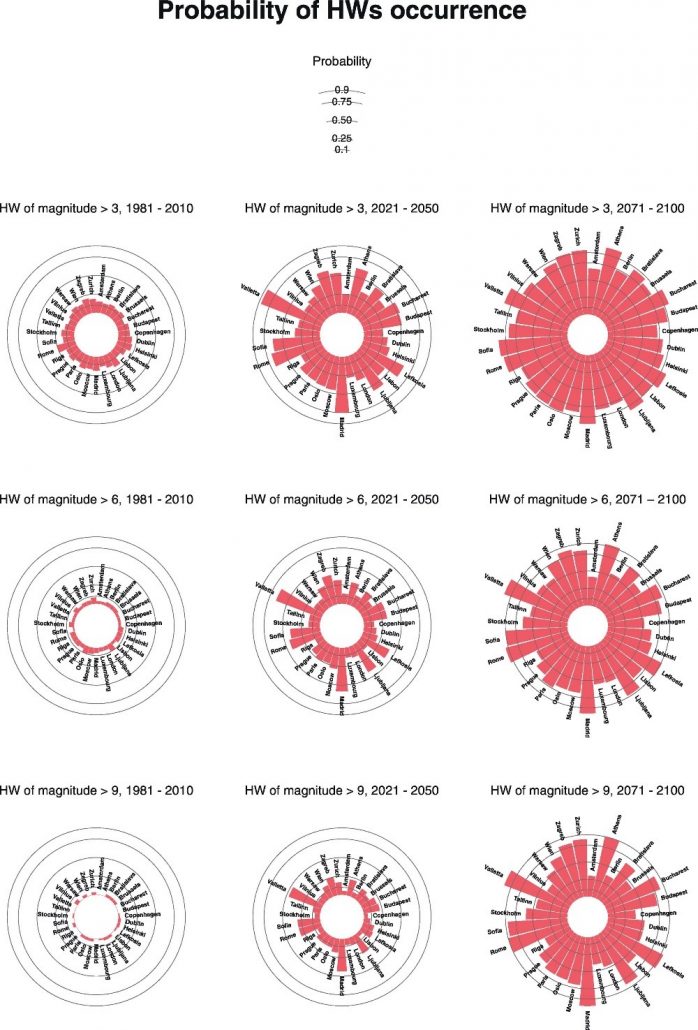
#Newpaper out: Ranking #European capitals by exposure to #heat #waves and #cold waves @ELSenviron
Are you worried about how quickly Europe is getting warmed? Will Madrid get warmer than Athens in 2030? in 2050? In 2100? Will the cities of central Europe experience strong heat waves in the future?
In a recent paper published in Urban Climate entitled “Ranking European capitals by exposure to heat waves and cold waves” (https://doi.org/10.1016/j.uclim.2018.12.010), leading author Marek Smid, one of the recent PhDs from the GEO-C project, explores these questions and shows the estimated evolution of heat waves and cold waves events by computing the Heat Wave (HW) and Cold Wave (CW) indices by using an ensemble of eight EURO-CORDEX models under the RCP8.5 scenario. According to Riahi and colleagues (https://link.springer.com/article/10.1007/s10584-011-0149-y), the Representative Concentration Pathways (RCP)8.5 scenario combines “assumptions about high population and relatively slow income growth with modest rates of technological change and energy intensity improvements, leading in the long term to high energy demand and GHG emissions in absence of climate change policies”. The study focuses on larger metropolitan areas of European capitals (EU28 capital cities plus Moscow, Oslo and Zurich).
The results of this research provide insights regarding the future evolution of temperature related to exposure of population across all the European capitals. We propose a classification procedure (ranking) for capital cities in terms of the impact of HW and CW, which reflects the variation in the impacts of extreme heat in different metropolitan societies by including population density as an additional exposure variable in the classification. For example, the visualization below shows a gradual increase in frequency and severity of extreme heat events. According to the proposed impact ranking, in the near and distant future, extreme heat events will not be exclusive of traditionally exposed areas such as the Mediterranean and the Iberian Peninsula. Most Europe will be getting warmer because severe, extreme and very extreme heat waves are more likely to occur from 2021 to 2050 to 2071-2100 in most cities.

Pre-print figure 3
The paper comes with an additional gift in the Appendix A – Supplementary data (https://ars.els-cdn.com/content/image/1-s2.0-S2212095518302700-mmc1.docx), almost like an extra paper. The main study is complemented by the description of the MetroHeat web tool (https://cgranell.shinyapps.io/metroheat/), a Shiny application to visualize, analyze, and download all the computed data used in the paper. This tool aims to increase transparency of the research, facilitates the comparisons with other studies because it takes into consideration reproducibility research principles (e.g., data and software are openly available), and more importantly foster dissemination of climate change issues to key stakeholders.
The abstract of the paper is:
In warming Europe, we are witnessing a growth in urban population with aging trend, which will make the society more exposed and vulnerable to extreme weather events. In the period 1950–2015 the occurrence of extreme heat waves increased across European capitals. As an example, in 2010 Moscow was hit by the strongest heat wave of the present era, killing more than ten thousand people. The cold extremes will have decreasing tendency as global warming progresses, however due to higher variability of future climates, the cold wave hazard may remain locally important threat. Moreover, the heat and cold-related mortality will be enhanced with foreseen demographic evolution in European cities.
Here we focus on larger metropolitan areas of European capitals (EU28 plus Moscow, Oslo and Zurich). By using an ensemble of eight EURO-CORDEX models under the RCP8.5 scenario, we detected heat waves and cold waves events by deployment of Heat Wave Magnitude Index daily and its cold wave counterpart. We introduce a ranking procedure based on ensemble predictions using the median of metropolitan grid cells for each capital, and population density as a proxy to quantify the future exposure.
All the investigated European metropolitan areas will be more vulnerable to extreme heat in the coming decades. Based on the impact ranking, results reveal that cold waves will represent some threat in mid of the century but they will not be the major threat in any of European capitals, and that they are projected to completely vanish by the end of this century. On the contrary, in near, but even more so in distant future, extreme heat events in European capitals will be not exclusive to traditionally exposed areas such as the Mediterranean and the Iberian Peninsula. The ranking of European capitals based on their exposure to extreme heat is of paramount importance to decision makers in order to mitigate the heat related mortality, especially with the foreseen increase of global mean temperature. Furthermore, this simple comparative indicator helps communicating the global, complex and impersonal issue of climate change locally thus contributing to raise awareness and call for action.
Full citation is: Smid, S. Russo, A.C. Costa, C. Granell, E. Pebesma (2019) Ranking European capitals by exposure to heat waves and cold waves. Urban Climate 27, 388-402, https://doi.org/10.1016/j.uclim.2018.12.010.
- Posted by geoadmin
- On 14 January, 2019
- 0 Comments




0 Comments